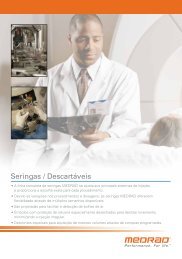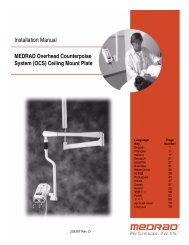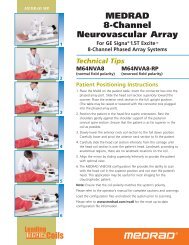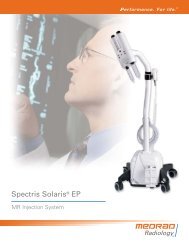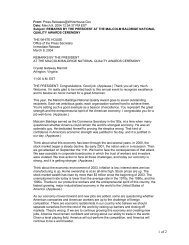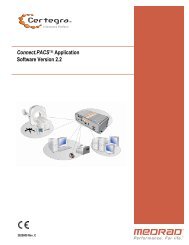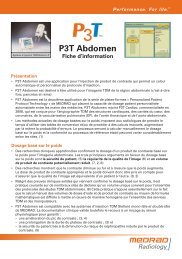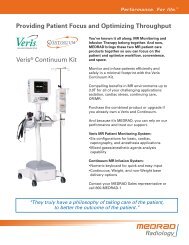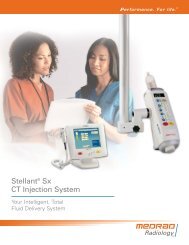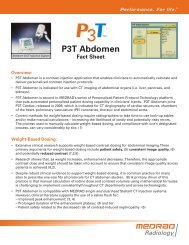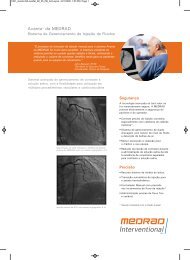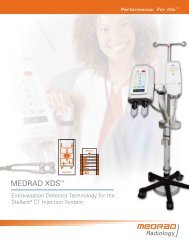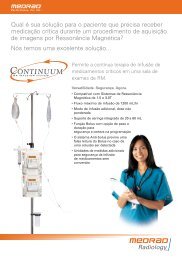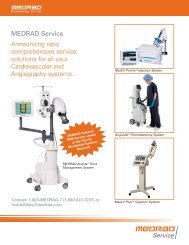2218-001 Spiroflex Brochure.pdf - Medrad
2218-001 Spiroflex Brochure.pdf - Medrad
2218-001 Spiroflex Brochure.pdf - Medrad
You also want an ePaper? Increase the reach of your titles
YUMPU automatically turns print PDFs into web optimized ePapers that Google loves.
AngioJet ® <strong>Spiroflex</strong> Thrombectomy Catheter<br />
Rapid Exchange with Exceptional Flexibility<br />
Unique Tip Design<br />
• Long taper tip provides excellent crossing profile<br />
• Soft tip material conforms and tracks through<br />
tight vessels<br />
• Bright orange tip for easier guidewire loading<br />
• 25cm guidewire lumen for faster loading<br />
and unloading<br />
Advanced Technology Shaft<br />
• Polymer-clad spiral-cut shaft. Flexibility increases toward<br />
the distal end to accommodate tight bends while retaining<br />
excellent pushability at the proximal end.<br />
• Distal shaft has hydrophilic coating to reduce drag<br />
and ensure smooth delivery.<br />
• Size and length are compatible with radial access<br />
procedures.<br />
Familiar Technology Used World-Wide<br />
Used in over 600,000 cases, the AngioJet System<br />
has established itself as a recognized therapy for<br />
thrombus removal.<br />
Patented Cross-Stream ® technology provides fast and effective<br />
360° thrombus removal.<br />
CAThETER SpECiFiCATionS<br />
System Compatibility AngioJet Ultra<br />
Vessel Diameter > 2mm<br />
Working Length 135cm<br />
Shaft Diameter 4F<br />
Double Marker Band 15 mm<br />
Guidewire Compatibility RX 0.014”<br />
Guide Compatibility 6F > 0.070”<br />
Sheath Compatibility 5F / 6F*<br />
oRDER inFoRmATion<br />
AngioJet Ultra <strong>Spiroflex</strong> Thrombectomy Set<br />
US part number 106553-<strong>001</strong><br />
International part number 106553-TAB<br />
For use only with the AngioJet Ultra System<br />
* With guide catheter<br />
Caution: Federal (US) law restricts this device to sale by or on the order of a physician.<br />
AngioJet<br />
<strong>2218</strong>-<strong>001</strong> 5/12<br />
® Thrombectomy Systems<br />
Indications/Contraindications<br />
AngioJet and AngioJet Ultra peripheral indications include: breaking up and removing thrombus from infra-inguinal peripheral arteries, upper and lower extremity peripheral<br />
arteries, upper extremity peripheral veins, ileofemoral and lower extremity veins, A-V access conduits, and for use with the AngioJet Ultra Power Pulse Kit for the control<br />
and selective infusion of physician specified fluids, including thrombolytic agents, into the peripheral vascular system. Coronary indications include: removing thrombus in<br />
the treatment of patients with symptomatic coronary artery or saphenous vein graft lesions prior to balloon angioplasty or stent placement. Do not use in patients: who are<br />
contraindicated for intracoronary or endovascular procedures, who cannot tolerate contrast media, and in whom the lesion cannot be accessed with the wire guide.<br />
Warnings and Precautions<br />
The system has not been evaluated for treatment of pulmonary embolism or for use in the carotid or cerebral vasculature. Some AngioJet devices have not been<br />
evaluated for use in coronary vasculature. Operation of the catheter may cause embolization of some thrombus and/or thrombotic particulate debris. Cardiac arrhythmias<br />
may occur and cardiac rhythm should be monitored during catheter use and appropriate management employed, if needed. Systemic heparinization is advisable to<br />
avoid pericatheterization thrombus and acute rethrombosis. Operation of the system causes transient hemolysis. Large thrombus burdens may result in significant<br />
hemoglobinemia which should be monitored. Consider hydration, as appropriate. Before coronary AngioJet treatment, verify the presence of thrombus because routine<br />
use of AngioJet in every STEMI patient, without proper selection for thrombus, has been associated with increased mortality risk. Do not use the system in the coronary<br />
vasculature without placing a temporary pacing catheter to support the patient through hemodynamically significant arrhythmias which may occur.<br />
Potential Adverse Events<br />
Potential adverse events (in alphabetical order) which may be associated with use of the system are<br />
similar to those associated with other interventional procedures and include but are not limited to the<br />
following: abrupt closure of treated vessel, acute myocardial infarction, acute renal failure, arrhythmias<br />
(including VF and VT), bleeding from access site, death, dissection, embolization (proximal or distal),<br />
emergent CABG, hematoma, hemolysis, hemorrhage requiring transfusion, hypotension/hypertension,<br />
infection at access site, myocardial ischemia, pain, pancreatitis, perforation, pseudoaneurysm,<br />
reactions to contrast medium, stroke/CVA, thrombosis/occlusion,<br />
total occlusion of treated vessel, vascular aneurysm, vascular spasm, vessel wall or valve damage.<br />
Refer to product labeling for device-specific indications, contraindications, warnings/precautions,<br />
and adverse events. Rx only. – COM January 2011<br />
The Bayer Cross, AngioJet, <strong>Spiroflex</strong> and Cross-Stream are registered trademarks of the Bayer group of<br />
companies. © 2012 MEDRAD, INC. All Rights Reserved.



